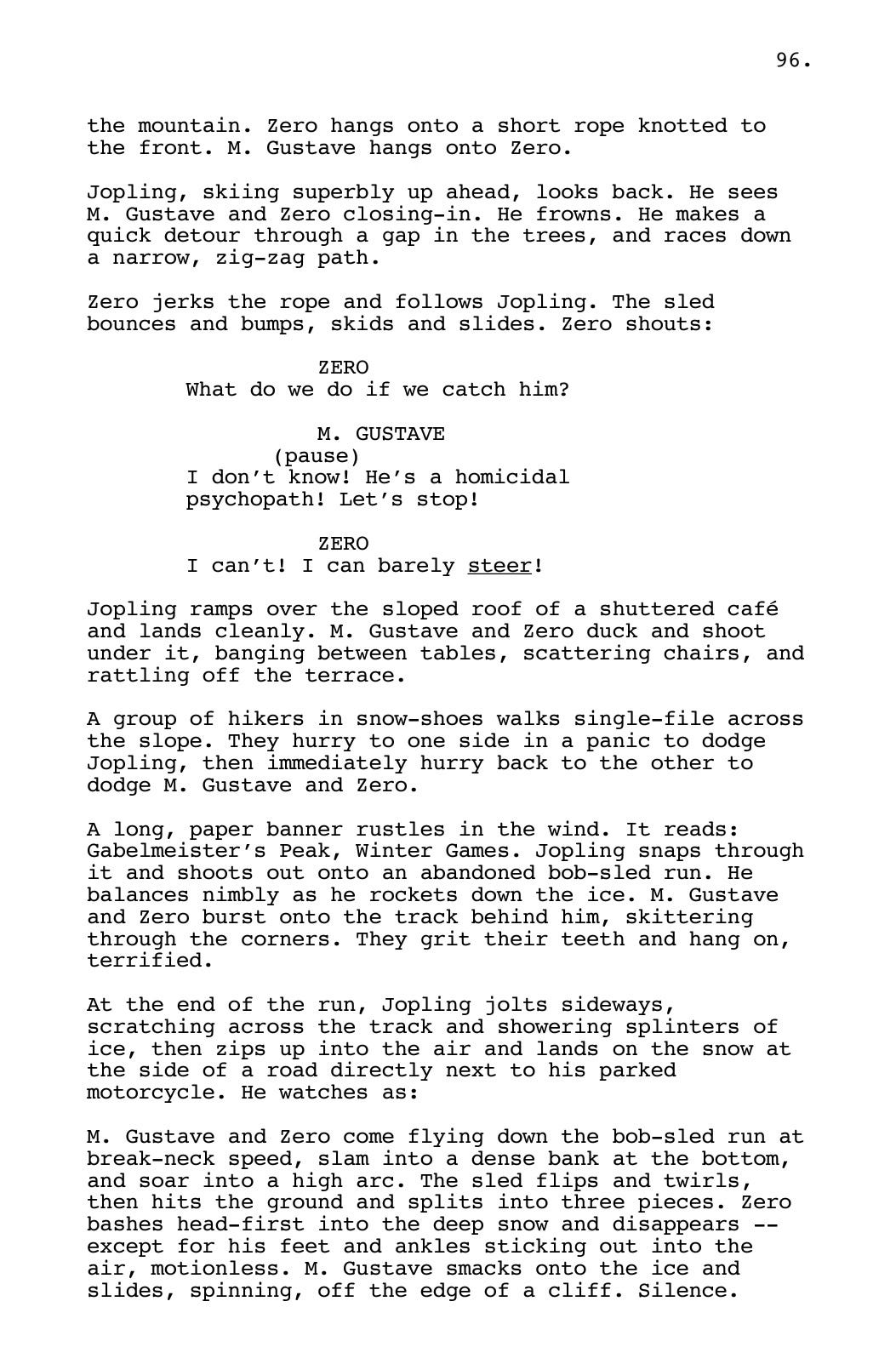The Grand Budapest Hotel (2014) Script Review | #25 WGA 101 Greatest Scripts of the 21st Century
The whimsy hides a dark and sad soul in this fabulous script that may be Wes Anderson's best work yet.
Logline: A writer encounters the owner of an aging high-class hotel, who tells him of his early years serving as a lobby boy in the hotel’s heyday under an exceptional concierge.
Written by: Wes Anderson
Story by: Wes Anderson and Hugo Guinness
Pages: 117
At its core, The Grand Budapest Hotel is about coping with loss and the melancholy of nostalgia; on the surface, it’s an amusing and colorful tale about a young lobby boy and his friendship with a hotel concierge.
The bulk of the story takes place in an alternate version of history around 1939 in the fictional Eastern European country of Zubrowska. Zero, an immigrant, has recently joined the illustrious Grand Budapest Hotel. The Hotel owes a great deal of its success to M. Gustave, the flamboyant hotel concierge. Gustave is cultured and polished, delighting in his generous use of perfume and quoting poetry. There’s a huge streak of vanity in him, and for some reason, he tends to sleep with the rich elderly female patrons of the hotel; notably, the dowager Madame D. As Gustave takes the young Zero under his wing, Madame D. dies and leaves Gustave a valuable painting, ‘Boy With Apple.’ But the concierge is accused of murder and imprisoned, prompting Zero to break Gustave out and help to clear his name before the dowager’s son, Dmitri, and his sinister henchman, Jopling, clear them off.
The 117-page script is divided into six parts (plus an untitled prologue), each lasting about 15-30 pages, and can be broken down as follows:
Prologue – Untitled (pg. 1-8) – 8 pages
Part 1 – M. Gustave (pg. 9-24) – 15 pages
Part 2 – Madame C.V.D.u.T (pg. 24-45) – 21 pages
Part 3 – Checkpoint 19 Criminal Internment Camp (pg. 46-75) – 29 pages
Part 4 – The Society of the Crossed Keys (pg. 76-87) – 11 pages
Part 5 – Gabelmeister’s Peak (pg. 87-109) – 22 pages
Part 6 – The Second Copy of the Will (pg. 109-117) – 8 pages
Although the narrative is deceptively straightforward, Wes Anderson wraps the story up in a nesting doll of different timeliness to create a ‘story-within-a-story-within-another-story’ effect. The nesting device is a technique used by writer Stefan Zweig in works such as ‘Beware of Pity’ and ‘The Post Office Girl.’ If one used a graphic to represent the way the nesting timelines work, it would look like this:
A: The Main Timeline – young Zero and Gustave – 1939 – most of the story
B: Second Timeline – old Zero and young Author – 1960s – where elderly Zero recounts his tale to the young Author staying at The Grand Budapest Hotel
C: Third Timeline – old Author – 1990s – where the elderly Author opens the story of how he came about the story that prompted him to write the book about Zero and Gustave
D: Fourth Timeline – young Girl – Present Day – where a young Girl reads the book, ‘The Grand Budapest Hotel,’ by the Author
So much is crammed into The Grand Budapest Hotel that it’s a wonder that it works so well and swiftly. Apart from all the shenanigans involving Zero and Gustave, there’s also a sub-plot revolving around the romance blooming between Zero and a young confectionary maker called Agatha. All of this happens on top of a prison break, a ski-chase, and the murder of a lawyer. Underneath it all, the looming specter of war threatens to puncture the idyllic picture of Zubrowska; an allusion to Hitler and his reign of terror in real-life.
Although Anderson is famous for his unique style, none of the specific camera movements and direction that he is known for are apparent on the page. That’s a deliberate choice; Anderson reasons that such writing is “boring to read.” Instead, he writes his scripts to be read. There is a literary quality to his words; his action lines can be small descriptive paragraphs, peppered with character and humor.
This even extends to the way he writes a montage.
And the ski chase, too.
Despite not getting specific about how to stage the visuals on the page, he has a talent for creating strong visuals, such as the scene in which an imprisoned Gustave addresses his colleagues via a letter dictated Zero.
For my part, my favorite scene is the sequence in which Kovacs, the lawyer, is stalked and killed by Jopling; only, the circumstances include an unforgettable visual of Kovacs losing his fingers when Jopling shuts the door on his hand.
Narration and voice-over play a great role in this script, a dicey writing device for screenplays as it can come off as a lazy crutch. Anderson manages to sidestep the problem by using narration in the early scenes to make it appear the characters are reading words from a book; the main narration comes from the elderly Zero, who provides enough context about the world and setting, as well remind us that we are listening to a story, as if told around a campfire. In doing so, he avoids the common pitfalls that narration tends to trip up many writers.
But even the greatest writing in the world cannot do much unless the characters are strong enough to capture our imaginations. Gustave and Zero are such an idiosyncratic pair that it’s a treat to watch them fumble out in the name of clearing Gustave’s name. It’s an unlike duo but, more than once, it’s shown just how Gustave feels about the lobby boy when he defends him from soldiers and, ultimately, bequeaths an entire fortune to the poor immigrant.
Zero, meanwhile, is ethnically ambiguous. His nationality is not specified, except for a brief and emotional instance when the young lobby boy reveals his reasons for leaving his homeland.
It is also Zero who has the emotional journey, growing and flourishing under Gustave’s tutelage. Gustave doesn’t really change except to become even richer by the end of the tale.
For most of the script’s duration, The Grand Budapest Hotel is a fun and delightful caper. But there are hints of darkness and sadness that creep in, slowly at first, then stronger around the script’s Midpoint at page 56, which is when Agatha enters the script in a bigger role. The elder Zero refrains from talking about Agatha until he has no choice but to bring her into the story; hers and Gustave’s fates are given in a few dispassionate lines that makes it disquieting.
The origins of The Grand Budapest Hotel date as far back as the early 2000s. Anderson and Hugo Guiness (who receives a ‘Story By’ credit) had a mutual friend who behaved exactly like Gustave, and the pair thought it would be fun to build a story around such a character. In early versions, however, the Gustave character is not a concierge; in fact, no hotel was included. He merely stole a painting, as happens here…
But Anderson and Guinness ran into a wall after 15-18 pages, and didn’t know how to proceed. It was around this time that Anderson came across the works of Zweig, which slowly helped the script get unstuck. After Anderson cranked out a draft in six weeks, he and Guinness began to research the world of concierges; for instance, the secret Society of the Crossed Keys group was inspired by The Golden Key, a real-life group of 14 high-class concierges. Along with being inspired by the films of Ernst Lubitsch and Billy Wilder, the script slowly coalesced into its present form. It was nominated for the Academy Award for Best Original Screenplay1, and won the Writers Guild of America Award and the BAFTA Award in the same category. For my money, it is the best of Wes Anderson’s screenplays— droll yet melancholy, like sweet candy with a bitter centre. An unforgettable combination.
Notes:
Seitz, Matt Zoller (2015) | The Wes Anderson Collection: The Grand Budapest Hotel
Stern, Marlow (March 4, 2014) | Wes Anderson Takes Us Inside ‘The Grand Budapest Hotel,’ His Most Exquisite Film (The Daily Beast)
Osenlund, R. Kurt (March 8, 2014) | Wes Anderson on Using Throwback Ratios, Romantic Worldviews, and European Reconnaissance to Craft The Grand Budapest Hotel (Filmmaker Magazine)
Other contenders that year for Best Adapted Screenplay as well as Best Original Screenplay which made the cut for the WGA List of 101 Greatest Screenplays of the 21st Century include: Birdman, Boyhood, and Nightcrawler in the Best Original category; and Whiplash in the Best Adapted category.















